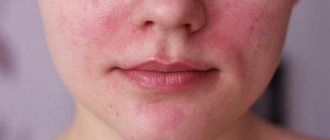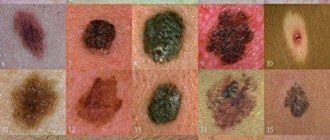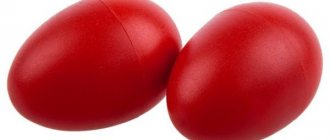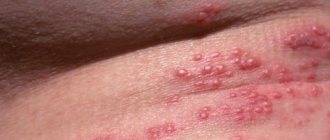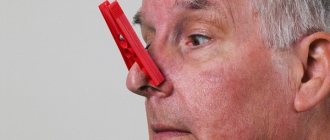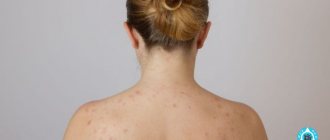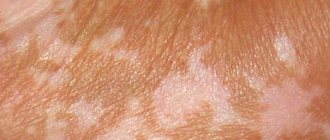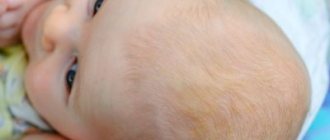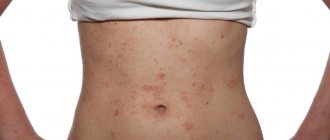The white spot symptom is observed during asphyxia in newborns, as well as during severe shock conditions. This property was discovered back in 1901 by the neuropathologist Manteuffel. Following him, the symptom was described in detail in their works by Laignel and Levastine in 1924.
The symptom is often a sign of obliterating endarteritis or neurointoxication. In states of shock, acute oxygen deficiency, a white spot can remain on the victim’s forehead or finger for more than 20 seconds.
What's happened?
Manteuffel's symptom, or in another way - the white spot symptom, indicates a lack of blood circulation in the capillaries of the lower and upper extremities, caused by heart problems or lack of oxygen.
It is observed in shock conditions due to blood loss. On the finger in the middle of the nail bed, when you press on the end of the nail, a clear white spot will expand and contract. The same spot will appear on the feet near the toes when you press your finger on the skin. A positive symptom is determined if the stain lasts for at least 3 seconds.
Why does the stain stick around and not go away immediately after pressing? This occurs due to increased excitability of the autonomic nervous system during shock.
Causes of birthmarks in newborns
Medicine does not know a clear answer about the reasons for the appearance of postpartum red spots in children. The defect appears as a pigmented area of skin that has:
- rich pink, red, brown color;
- smooth or rough surface;
- flat or protruding areas above the skin level;
- small or giant area;
- smooth or asymmetrical edges;
- different localization.
A detailed description of spots in children depends on their type, causes of occurrence, and the course of pregnancy. The main reasons for the appearance of birth pigmentation in newborns are:
- Hypoxia of blood vessels from compression during childbirth or late pregnancy:
- infectious diseases of the expectant mother;
- prematurity of the child.
If we are talking about vascular pink or red pigmented moles, they are most often localized on the child’s head: in the back of the head, on the chin, forehead, nose, bridge of the nose, cheeks, eyelids, and the baby’s upper lip. Brown pigmentation, called moles or nevi, can be located on any part of the body, just like hemangiomas. The formations are benign, but require careful observation by a specialist and subsequent removal, since they carry the risk of cells degenerating into melanoma and spoiling the appearance. Defects never go away on their own, unlike vascular birthmarks, which disappear on their own.
Symptom of a white spot during suffocation
Sometimes complications occur during childbirth: the fetus is entangled in the umbilical cord, malpresentation, or other reasons. Such accidents during childbirth lead to the fact that the child lacks oxygen and is born with asphyxia. In this case, breathing and heartbeat may be completely absent, or breathing may be intermittent and inconsistent.
The Apgar score is an overall assessment of a newborn's suffocation in the first minute of life. Based on the symptoms described in the table, doctors can differentiate between mild, moderate and severe asphyxia of the newborn.
White spot syndrome is present in severe to moderate suffocation. Within a few seconds of pressing on the heel, the stain does not go away. If breathing is extremely weak and there is no heartbeat, the neonatologist must take urgent measures to restore breathing and heart rhythm.
With timely assistance, the child quickly restores respiratory function. However, it is necessary to conduct some research and find out whether damage to brain tissue began from a lack of oxygen.
When will the red spots go away? PHOTO
We’ve had the same ones for a year now, they’re almost gone, but if it starts to push, it’s noticeable, in general they told us it’ll go away by 1.5-2.
Did you know that half of newborn babies have marks on their skin that prove they were carried by a stork or kissed by an angel? The beautiful tale is supported by red spots on the neck or face, called telangiectasia . Why do they occur when they pass? How do they affect the baby's health?
Why do red spots appear on the skin of a newborn?
During the last weeks of pregnancy, the fetus moves into the position in which it will be born. The closer he gets to giving birth, the more cramped he becomes in his cozy “house”. Therefore, he is forced to bend his head as much as possible, pressing his chin to his chest, cross his arms in front and strongly bend his legs apart at the hip joints. This fetal position with the butt up is called occipital presentation and is the most common. There are times when the baby’s head does not bend, but tilts back strongly. In such cases, the presenting part is not the crown, but the face.
The baby is under pressure from all sides not only from the muscular wall of the uterus, but also from the mother’s pelvic bones. In those places where the bone strongly presses the skin, local focal ischemia occurs, that is, insufficient blood supply to the tissue. With an occipital presentation, this area most often becomes the hair growth area on the back of the neck (“stork bite”), with a facial presentation – the upper lip, bridge of the nose (“angel’s kiss”), eyelids, tip of the nose, chin. In these places, due to severe oxygen starvation, superficial blood vessels dilate. This is why telangiectasias are usually deep red in color.
Why do postpartum spots in newborns not disappear for a long time?
Telangiectasia gradually fades over time, appearing brighter with anxiety or severe stress. Usually by the age of five they disappear completely. But in some cases, red spots remain for life. The reason lies in damage to the branch of the cervical sympathetic nerve due to strong flexion or hyperextension of the head. This occurs when passing through the birth canal during pushing. Until the nerve fiber recovers from injury, the blood vessels of the telangiectasia zone cannot narrow on their own and remain constantly dilated as much as possible. When the nerve “recovers,” it begins to send impulses that cause the arterioles and venules of the spot to contract. If the damage was very severe and irreversibly destroyed the sympathetic nerve fiber, the red spots will remain for life.
There is a version about the hereditary transmission of the tendency to the formation of persistent telangiectasia due to a congenital abnormality in the development of the wall of blood vessels.
Where are red spots located in newborns?
In addition to the most common locations already listed, telangiectasias can be seen on the child’s back, along the spine. In the lumbar region, they can merge, forming a large triangle or rhombus up to 4 cm in size. With such localization, it is advisable to show the baby to a neurologist to exclude a congenital anomaly of the spinal cord, manifested by the so-called flaming nevus, very similar to telangiectasia. As a rule, such stains persist for a long time.
Less commonly, “angel’s kiss” is found on the butt, forehead, neck and along the entire length of the occipital bone.
How does a vascular spot in a newborn affect his health?
There are no negative consequences for a child from telangiectasia. The only rare problem is a cosmetic defect, when bright or large spots on the face are too noticeable.
How to treat postpartum spots
These formations do not require treatment. Even the largest and most persistent of them do not increase in size and gradually turn pale.
Signs of suffocation
Hypoxia (from Greek) - lack of oxygen (ancient Greek ὑπό - below + Greek οξογόνο - oxygen). People say - suffocation. It happens in children and adults, for example, with carbon monoxide poisoning. The following signs may indicate suffocation:
- Blue skin.
- Weakness.
- Dizziness.
- Headache.
- Possible nausea.
- White spot symptom.
Due to lack of air in the blood, the capillaries in the extremities immediately suffer. One of the characteristic signs of hypoxia is the studied manifestation lasting 3 seconds. Pressure should be applied to the base of toes 1-3 and held for about 2-3 seconds.
Redness on the child's body
The most common causes of redness on a child’s body are the following:
- Various allergic reactions that can occur due to poor diet and wearing clothes that contain toxic substances. Playing with objects that also contain toxic substances.
- In addition, redness can be caused by the presence of pets in the house, a woolen carpet, or any other fabrics that can cause allergies on a child's sensitive skin.
- Redness on the skin may be caused by the diaper coming into contact with the baby's skin. In this case, it is enough to simply fasten the diaper not too tightly.
- Redness can be a symptom of diseases such as eczema, lichen or dermatitis.
- In addition, redness is a symptom of more serious diseases that are infectious. These include measles, rubella, or scarlet fever. As a rule, in these cases, redness looks like a rash and is accompanied by an increase in body temperature.
- Also, the cause of redness on the skin can be ordinary overheating, frostbite of the skin (very often a child’s cheeks turn red due to these reasons). It is also possible that the redness was caused by burns.
Shock states
In cases of shock due to severe fractures, knife wounds and blood loss associated with injury, it is imperative to check the white spot symptom. If it is, it means that the body has already lost a lot of blood and is experiencing a lack of nutrients and oxygen. With grade 3 shock, the amount of blood loss reaches 50%, and the total heart rate is 130–140 beats. in a minute.
Any shock occurs in 2 phases. The shock reaction begins with the erectile phase, when psychomotor agitation increases. Then comes the torpid phase, when the pressure gradually drops. The normal symptom of a white spot is literally a couple of seconds. If the mark persists for more than 5 seconds, then the second phase begins with a drop in cardiac output and the skin becomes paler.
The shock caused by a heart attack, or cardiogenic shock, results in a sharp decrease in cardiac blood output. This leads to hypoxia and in 90% of cases to instant death.
In case of shock, qualified first aid is necessary for the patient. His skin becomes damp, cold due to the drop in temperature, and acquires an unusual marble shade. The pressure drops sharply and the person loses consciousness. The white spot symptom in shock caused by a heart attack is useless to check.
How to get rid of birthmarks
Most birthmarks disappear on their own as the child grows older; this does not apply to nevi. A postpartum spot, if it is on the face and interferes with the normal development of the child, should be removed. It is necessary to get rid of pigmentation under sterile medical conditions with an experienced doctor so that the procedure is painless and has no consequences for the small patient.
Infrared radiation is actively used in cosmetology to remove postpartum spots. The principle of action of the rays is based on the ability to heat the area of influence and enhance regeneration processes in tissues.
Laser therapy is the most popular method of removing skin defects. The action of the technique is based on the gradual evaporation of the tissues of the pigmented area, allowing you to act only on the nevus, leaving healthy tissues untouched.
Surgical removal of birthmarks is used if the affected area is large and there is a suspicion of the presence of malignant cells in the skin. The disadvantage of the operation is a possible scar. An experienced doctor will reduce the risk of its occurrence to a minimum.
Prevention measures
Like any disease, skin irritations can be prevented, you just need to remember about prevention. In order to prevent the appearance of a rash on the baby’s face, you need to:
- Bath your baby every day. For the bath, you can use an infusion of chamomile, string, and nettle;
- Try to maintain the air temperature in the rooms from 18 to 21C° and humidity 70%;
- When breastfeeding, stick to a diet. If you understand that everything is not so simple, create a menu with your nutritionist;
- If a rash appears, do not treat your face with a solution of potassium permanganate, alcohol solutions, hormonal and antibacterial drugs. First find the cause and only then establish treatment procedures.
